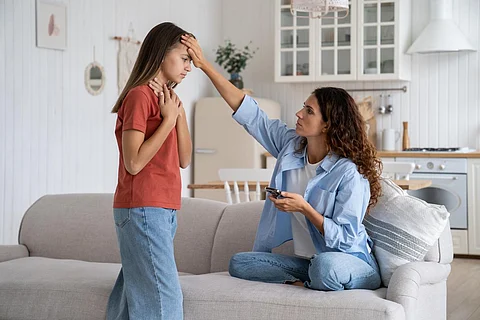Fever is one of the most common reasons parents seek medical care for their children. While it can be alarming, fever is the body’s natural response to infections. In most children, a normal body temperature is about 98.6°F (37°C), though it can fluctuate slightly throughout the day. A fever is generally defined as a temperature of 100.4°F (38°C) or higher.
Although a fever may cause concern, it is also a sign that the immune system is hard at work to fight off an infection.
Symptoms of fever in a child
The signs of a fever in children can vary depending on their age and the severity of the fever. Some common symptoms may include the following.
Warm or hot forehead: A fever is often first noticed by feeling the child’s forehead, though a thermometer is needed for an accurate reading.
Sweating or chills: Children with a fever may alternate between feeling hot and sweaty or cold and shivering.
Flushed skin: Their skin, particularly the cheeks, might appear red or flushed.
Irritability: Infants and young children can become more fussy or irritable when they have a fever.
Fatigue: Children might be sleepier than usual or seem less active.
Dehydration: Fevers increase fluid loss, so the child may have dry lips or cry without producing tears.
Loss of appetite: A fever can suppress a child's appetite, making them less interested in eating.
Common causes of a fever in a child
Fever can have many causes, ranging from mild infections to more serious illnesses. The most common causes of fever include the following.
Viral infections: These are the leading cause of fevers in children and include illnesses like the common cold, flu or other respiratory infections. Viral fevers usually resolve on their own without specific treatments.
Bacterial infections: Infections like strep throat, ear infections, urinary tract infections or pneumonia can cause fever. These may require antibiotics for treatment.
Teething: Although teething can cause a slight increase in body temperature, it typically doesn’t result in a true fever.
Immunizations: Some children may develop a low-grade fever after receiving vaccines.
When is a fever too high for a child?
Always ensure you are following the thermometer instructions to obtain accurate temperatures. Rectal thermometers are most accurate for measuring infant temperatures. Fevers themselves are not dangerous.
Infants (< 3 months): A fever of 100.4°F (38°C) or higher in a newborn is considered a medical emergency. Babies this young have underdeveloped immune systems, and any fever could signal a serious infection.
Infants and children (>3 months): Repeated temperatures above 104.0°F (40°C) or persistent temperatures of 100.4°F (38°C) for more than 3 days warrant a call to your child’s physician.
Medications to reduce a fever in a child
If your child seems uncomfortable due to a fever, you can help reduce their temperature using over-the-counter medications. Be sure to use the correct dosage based on the child’s weight.
Acetaminophen (Tylenol): This is safe for infants over 2 months old.
Ibuprofen (Advil, Motrin): Ibuprofen can be used in children over 6 months old.
Never give aspirin to a child due to the risk of Reye's syndrome, a rare but serious condition.
How can I reduce fever in a child naturally?
In addition to medications, there are several natural remedies to help reduce a fever.
Keep the child hydrated: Offer plenty of fluids like water, diluted juice or oral rehydration solutions to prevent dehydration.
Dress them lightly: Avoid bundling your child in heavy clothing. Light, breathable clothing helps cool the body.
Use a lukewarm sponge bath: Sponging your child with lukewarm water can help reduce body temperature. Avoid cold baths as they can cause shivering, which might raise the body temperature further.
Maintain a cool environment: Keep the room comfortably cool and use fans if needed to improve air circulation.
When should I see my child's doctor about a fever?
As an attending physician at Boston Children's Hospital, I know that although most fevers can be managed at home, there are times when it’s important to consult a healthcare provider.
Fever in infants under 3 months: Contact your doctor immediately if your newborn has a fever.
Fever lasting more than 3 days: If the fever persists for several days without improvement, it’s a good idea to seek medical advice.
Fever with other concerning symptoms: If your child is having trouble breathing, persistent vomiting or diarrhea, a stiff neck, severe headache or an unexplained rash, these could be signs of a more serious illness. Seek medical attention immediately.
Febrile seizures: While febrile seizures (seizures triggered by fever) are not usually dangerous, it's important to talk to a doctor if your child experiences one for the first time.


